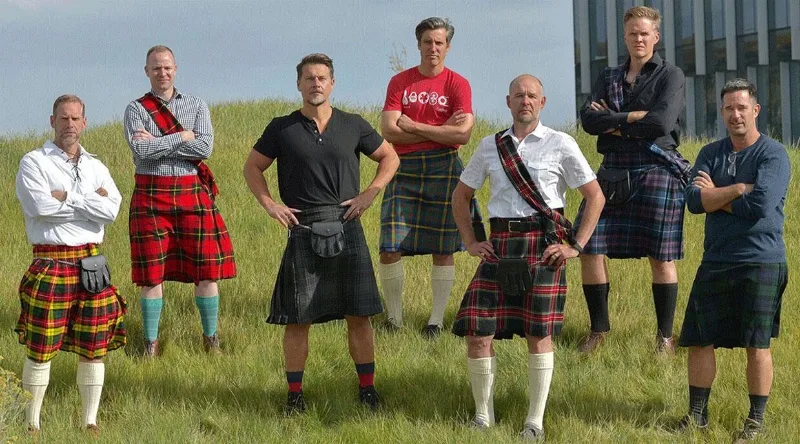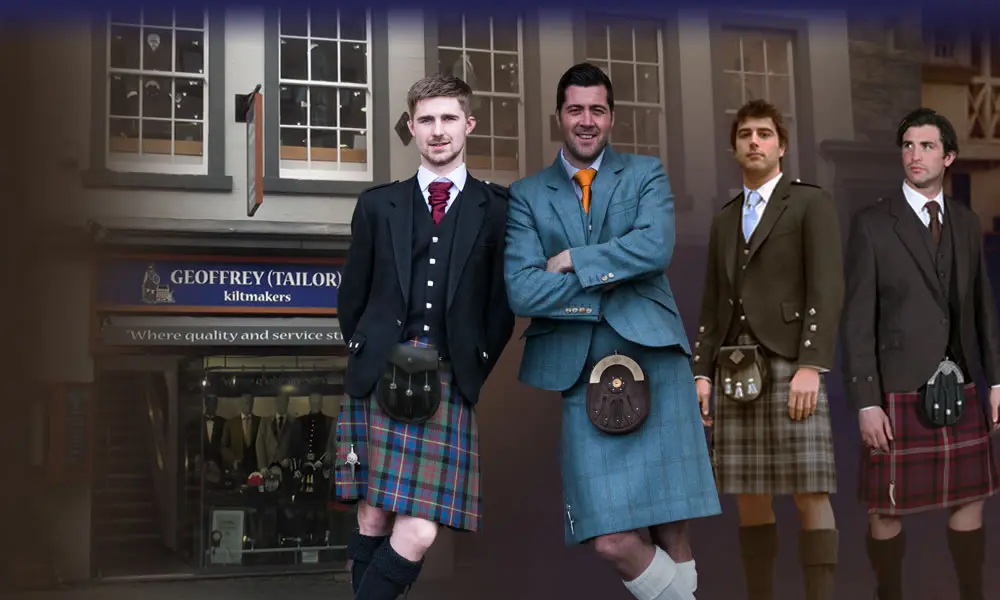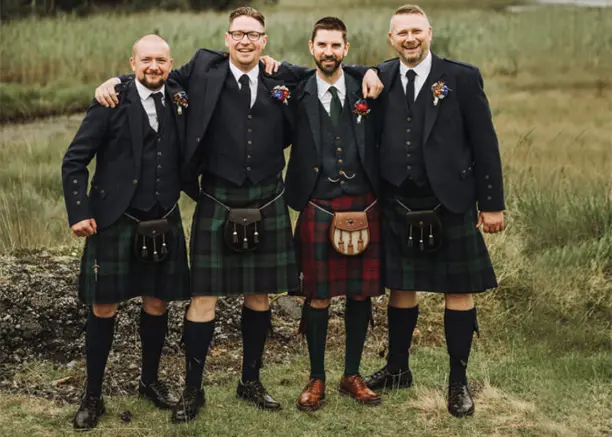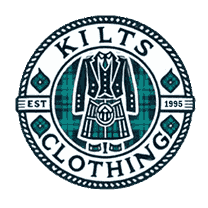Irish Kilt vs Scottish Kilt: The Timeless Tale of Kilts

Mens Kilt, those iconic garments often associated with Scotland and Ireland, have fascinated people around the world. They evoke a sense of tradition, heritage, and distinct style.
But are kilts Scottish or Irish? To unravel this intriguing question, we need to dive into the history, cultural significance, and evolving fashion of kilts.
A Glimpse into the Kilt’s Origins
The mens kilt story begins long before it became the recognizable garment it is today. Its roots can be traced back to the ancient Celts, who inhabited parts of Europe, including what is now Scotland and Ireland.
These early Celts wore tunics and cloaks made from wool or linen, but the specific garment known as the kilt evolved much later.
The Evolution of the Kilt
The Scottish kilt, often referred to as the “great kilt” or belted plaid, began to take shape in the 16th century. The great kilt was essentially a large piece of woolen fabric, about 6 to 8 yards in length,
which was draped around the body and secured with a belt. This style of kilt provided versatility and warmth, making it ideal for the harsh Scottish Highlands.
The kilt’s design and functionality were influenced by the need for practicality and adaptation to the Scottish climate. Highlanders would use the extra fabric as a cloak or cover during adverse weather conditions.
The kilt’s distinctive pleating and tartan pattern helped in identifying different clans and families, with each tartan pattern becoming a symbol of clan allegiance.
The Scottish Kilt: Tradition and Style
When we talk about Scottish kilts, we’re referring to a rich tradition of Highland dress that’s become a hallmark of Scottish culture.
The Scottish kilt skirt is known for its unique tartan pattern—a crisscrossed design featuring various colors and patterns. Tartan patterns are often associated with specific clans or regions, creating a personal connection to Scottish heritage.
How to Dress a Kilt
Dressing in a Scottish kilt involves several key elements:
1. The Kilt Itself: Typically made from wool, the kilt is about 8 yards long and features pleats at the back. The fabric is wrapped around the waist and secured with a belt.
2. Kilt Belt and Buckle: This accessory keeps the kilt in place. It is often an ornate piece of metalwork, adding both function and style.
3. Kilt Pin: Attached to the front of the kilt, the pin prevents the pleats from flying open and adds a decorative touch. It often features intricate designs or family crests.
4. Kilt Hose and Flashes: Knee-length socks, known as hose, are worn with garters or flashes that add a splash of color and help hold the socks in place.
5. Kilt Jacket: This is a tailored jacket worn over the kilt for formal occasions. It comes in various styles, including the Prince Charlie jacket for formal events and the Argyll jacket for more casual or business settings.
Scottish Kilts at Weddings
Scottish weddings are famous for their traditional kilt attire. The *wedding kilt* is a special variant worn by the groom and groomsmen, often in the family's tartan.
These kilts are paired with formal accessories such as a kilt jacket, waistcoat, and sporran, creating a distinctive and memorable appearance. The inclusion of the kilt at weddings not only celebrates Scottish heritage but also provides a unique and elegant look for the special occasion.

The Irish Kilt: A Different Yet Familiar Tale
While the kilt is most famously associated with Scotland, *Irish kilts* have their own unique place in Irish culture. Historically, kilts were less prevalent in Ireland compared to Scotland,
But they have seen a resurgence in recent years, particularly at cultural events and festivals.Much like the Scottish kilt, the Irish kilt is a symbol of heritage and pride, but it carries with it a unique flair and cultural significance that reflects the rich tapestry of Irish history and identity.
Do the Irish Wear Kilts?
Yes, *the Irish do wear kilts*, though it is less common than in Scotland. The Irish kilt is similar in design to the Scottish kilt but often features different tartans and patterns.
These kilts are typically worn for ceremonial purposes, such as Irish weddings and cultural festivals, rather than for everyday wear.
The Origins and Evolution of the Irish Kilt
The Irish kilt, also known as the Irish kilted skirt, has its origins in the early 19th century, drawing inspiration from the Scottish tradition but evolving into a distinct style of its own.
Unlike the great kilt of Scotland, which dates back to the 16th century, the Irish kilt began to take shape more recently, influenced by the changing dynamics of Irish society and the resurgence of Irish nationalism.
The Irish kilt typically features a tartan pattern, similar to its Scottish counterpart, but it often has a more understated and subtle design.
This reflects the Irish preference for a more restrained and elegant expression of their heritage. These traditional kilts for men are made from wool, the Irish kilt is often designed with less volume than the Scottish kilt, providing a sleek, streamlined look that is both practical and stylish.
The Irish Kilt: Tradition and Style
The Irish kilt is more than just a garment; it's a living expression of Irish culture and pride. Its design, while reminiscent of the Scottish kilt, carries a unique elegance that is deeply rooted in Irish tradition.
The tartan patterns worn in Irish kilts are often associated with specific Irish families or regions, similar to the Scottish clans, but they may feature different color schemes and patterns that reflect Irish heritage and history.
Irish Kilts at Special Occasions
he Irish kilt shines brightest at special occasions, such as weddings and cultural festivals. At Irish weddings, the groom and groomsmen often wear the Irish kilt to celebrate their heritage in a dignified and stylish manner.
The kilt, paired with a well-fitted jacket and carefully chosen accessories, creates a striking and memorable appearance that honors both tradition and personal style.
For those who wear it, the Irish kilt is more than just a piece of clothing; it’s a symbol of heritage, pride, and the timeless connection to a rich cultural history.
Whether at a wedding, a family gathering, or a cultural event, the Irish kilt stands as a proud testament to the enduring spirit of Ireland and its people.

Modern Kilts: A Fashion Evolution
Kilts have evolved significantly from their traditional scotland kilt roots. Today, you can find various styles and types of kilts that cater to different needs and occasions:
- Sport Kilts:
Made from lighter, more flexible materials, sport kilts are designed for comfort and durability during athletic activities. They are ideal for those who want to enjoy the kilt tradition while staying active.
- Casual Kilts:
Designed for everyday wear, casual kilts are made from more relaxed fabrics and styles. They can be paired with casual shirts and shoes for a comfortable yet stylish look.
- Formal Kilts:
Reserved for special occasions, formal kilts are made from high-quality wool and worn with elegant accessories. These kilts are ideal for events such as weddings and formal gatherings.
Conclusion: The Kilt's Enduring Legacy
Whether Scottish or Irish, the mens kilt remains a powerful symbol of cultural heritage and personal style. Its journey from ancient Celtic attire to modern fashion statement reflects its enduring appeal and adaptability. From traditional Scottish weddings to contemporary Irish celebrations, the kilt continues to captivate with its rich history and unique charm.
So, whether you’re considering donning a kilt for a wedding, sporting event, or simply for the love of its heritage, you’re participating in a tradition that bridges centuries and cultures. The kilt, with its blend of history, style, and personal significance, is more than just a garment—it’s a timeless piece of cultural artistry.
The kilt is a celebration of tradition, identity, and craftsmanship. Its enduring legacy is a testament to its significance in both Scottish and Irish cultures, reflecting a deep connection to history, family, and heritage. Embracing the kilt means embracing a piece of history that continues to evolve and inspire, making it a garment that truly stands the test of time.
FAQs
A tartan sash is typically draped over the shoulder and secured with a brooch. It can be worn over one shoulder or across the body, depending on the occasion and personal preference.
In the rich tapestry of Scottish tradition, women traditionally wear a tartan sash over the left shoulder. This positioning is not just a matter of style, but a sign of respect for the deep-rooted cultural norms of Scotland.
To ensure your comfort, drape the sash over your dominant shoulder and fasten it with a brooch at the shoulder or hip. The key is to make sure it hangs evenly and comfortably, allowing you to move with ease.
A mini tartan sash can be worn similarly to a regular sash but is often styled around the waist like a belt or over the shoulder for a more contemporary look.
A sash is typically draped over one shoulder and fastened with a brooch or pin at the hip or shoulder. It should hang neatly and not restrict movement.
A Cornish tartan sash is worn over the left shoulder and secured with a brooch. It follows the same traditional styling as other tartan sashes but features the unique Cornish tartan pattern.
A Scottish tartan sash is worn over the left shoulder and fastened with a brooch. It can be styled in various ways, such as across the body or over the shoulder, to reflect personal preference and occasion.

